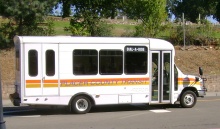About Transit.wiki
| Help | Special pages |
|---|---|
Welcome to the Transit.Wiki. This wiki is a guide to all buses, trains, ferries, and more to help people travel independently without automobiles.
By presenting a consistent interface, this wiki fills in the gaps left by the official transit web sites. It complements transit trip planner with information and knowledge experienced riders have picked up along the way.
How can you get involved?
It takes a great deal of effort to include and maintain information for about 659 transit agencies, along with thousands of destinations served by transit.
Become a contributor
- Sign up for an account here (expect a turnaround time of up to 24 hours)
- Start editing
We welcome contributors who are interested in sharing their knowledge about transit.
Please see the help section if you want to get started on editing. The most important part is the Semantic features section, because this wiki highly depends on Semantic Mediawiki due to its ability to query information.
We are looking for expansion into new states and regions, with the ultimate goal of covering every transit agency in the United States. If you're interested in covering a new region, contact User:Andy for methods to input large amount of information rapidly to reduce the time needed to cover new agencies.
Corrections
If you work for a transit agency or a private provider, you may use the contact form to request corrections (you can also sign up for account and do it yourself if interested). We will make the necessary changes as soon as possible.
Guiding principles
- This IS a travel guide, not Wikipedia. Wikipedia does not like detailed transit information on articles where the main topic is not transit. Here, everything is about transit.
- Standards and conventions on this wiki are not the same as Wikipedia.
- This wiki can use images and icons uploaded on Wikimedia Commons (used by Wikipedia).
- We provide a human review of transit information that is widely available in machine readable formats like GTFS.
- We provide details useful for new riders that savvy riders take for granted, but less of transit fan/insider information and discussions often presented on Wikipedia.
- We strive to provide accurate transit information on the simplest terms.
- If the transit agency maintains a quality web site with stable permalinks to schedules for each route, we will have direct link from here to there on each route.
- If the agency's information changes frequency and not as well organized, we will link to them in a way to minimize 404 not found errors and avoid accessing outdated information remaining on the agency's server.
- Unless you are willing to commit to follow up transit agency closely, avoid including information in a level of detail that requires constant maintenance. That's why information such as weekend bus detours are not written onto the wiki. As an alternative, we embed readily available sources such as Twitter feed.
- One of the reasons we use Semantic MediaWiki because it allows other pages to include route information by querying the route pages. If the same level of information has to be edited by hand (like how it is on Wikipedia), the task would be impossible even for a single large transit agency.
- We present information at a depth that is meaningful.
- Information can certainly be very detailed, even for each bus stop, to justify having its own page. But hand edited information for each bus stop is time consuming to maintain and not very meaningful for transit riders (many of the bus transfers require crossing a street, if not walking up or down a block, rather than waiting at the same bus stop).
- We instead pull one level up and have hand edited information to focus on transit centers, major intersections, and destinations as groups of nearby bus stops.
- We use maps to show individual stops for a transit route (e.g. Map:1 California) with available GTFS and real time API data. Bus stops shown on a map is highly meaningful, especially with street view and real time features. The use of GTFS and real time feeds require minimal maintenance as long as transit agencies maintain on their part, which they need to do anyway for all of their information platforms.
- Information presented must be viewable from mobile devices. Avoid tall and wide wiki tables that will get squashed when viewed on an iPhone. Many people look for transit information on the street with mobile devices.
Structure of the wiki
Most pages on this wiki fall under these categories:
| Page types | Purpose |
|---|---|
| Cities | List of popular destinations and transportation hubs in city |
| Counties | List of cities and intercity transportation hubs in county |
Points of interest
|
List of transit routes serving that destination |
| Transportation hubs | List of transit routes serving that hub, along with information on available amenities along with bike and automobile parking. Real time transit arrival information is available for agencies that provide such service via API. |
| Transit routes (bus, rail, ferry) | Links to schedules, maps, fares, and a list of points of interests and transportation hubs served. |
| Transit providers | Routes, fares, service updates from Twitter and/or Facebook (if available) |
These pages help provide a virtual tour of each leg of the transit trip and complements online transit trip planners:
Hayward ► Hayward Station (BART) ► BART Fremont - Daly City Line ► Embarcadero Station ► N-Judah ► 2nd & King Station ► Oracle Park
Transit routes suitable for the wiki
Services included should be open to the public and can be used for trips in lieu of automobiles.
| Services should be included in wiki | Services that aren't so suitable |
|---|---|
Service may be provided by public agencies, non-profit groups, or private companies. |
|



